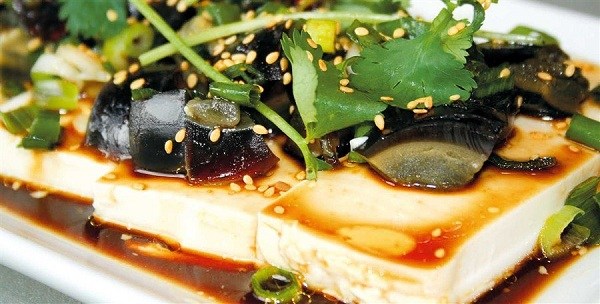
Pidan with soft tofu
One of the most contentious dishes in Chinese cuisine, at least where foreigners are concerned, is no doubt pidan, also called "thousand-year-old eggs." CNN once described it as the world's most disgusting food.
But Chinese people and some foreigners would disagree. It's really just a matter of taste, just like Limburger cheese, whose strong smell either delights or repels people.
The various methods of preserving eggs originated hundreds of years ago before refrigerators were around to extend the life of perishable foods. Preserved egg dishes have been part of many Chinese regional cuisines for centuries, and local cooking styles and seasoning vary widely.
Pidan is the most well-known of the preserved egg dishes in China. Perhaps the characteristic black color gave rise to the moniker "thousand-year-old" eggs, but the preserving process actually takes only weeks. In China, the snowflake patterns on the egg whites give the eggs the name songhuadan.
There are several tales of how and where pidan was originated.
One story traces back to Wujiang County in Jiangsu Province during the Ming Dynasty (1368-1644), when a small restaurant owner accidently poured soaked tea leaves in the stove ash where his ducks usually laid their eggs. Later, when he was cleaning out the ash, he is said to have found some eggs that he had missed collecting earlier. When he removed the shells, he discovered the polished dark eggs with white patterns had a distinct aroma and tasted smooth and delicious.
Several places in China are renowned for their preserved eggs, including Yiyang in Hunan Province, Yichun in Jiangxi Province and Gaoyou in Jiangsu Province.
Transforming fresh duck eggs into the black colored, gelatin-like pidan takes two to eight weeks, depending on the temperature. The coating is made from a mixture of quicklime powder, sodium carbonate and plant ash.
To make them, salt is added to a dry wok and stirred constantly until a cracking sound is hear. Then water is added and brought to the boil. The water is then left to cool before the powder mixture is stirred in to a muddy consistency.
The duck eggs are then individually wrapped in the "black mud" and rolled on rice husk. In a jar or pot, the eggs are carefully arranged and the contained sealed off from all air. It's best kept at room temperatures of between 15 degrees and 30 degrees Celsius for about a month. The eggs are ready earlier on hotter days.
Pidan is a controversial food in the modern diet. Traditional recipes often add yellow lead powder to kill bacteria, accelerate the protein denaturation and darken the color.


















































